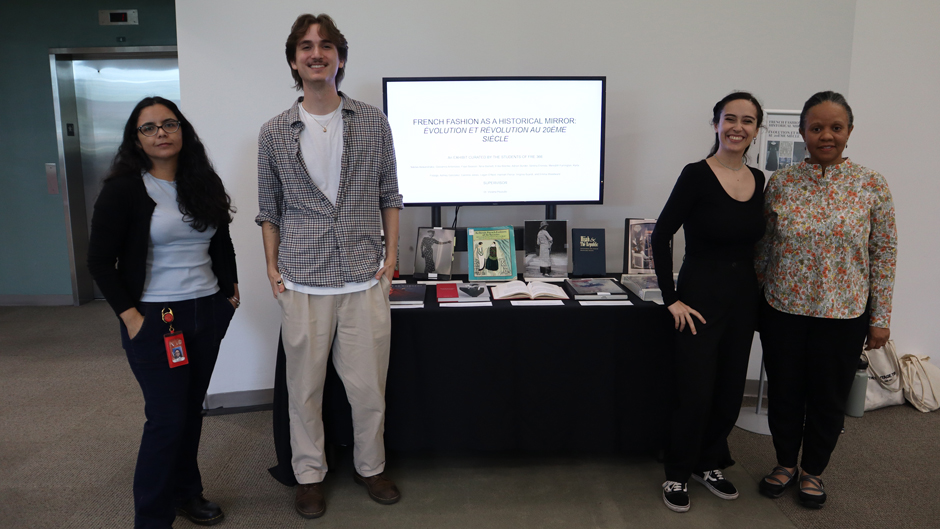In her “20th and 21st Century Topics in French” class, Viviana Pezzullo teaches the importance of historical context when learning a language. She achieves this by creating opportunities for her students to have nuanced conversations about social and political themes in France’s history through a semester-long project that is museum-worthy.
Through teamwork, research, and creativity, students in this upper-level French course at the University of Miami College of Arts and Sciences take a closer look at French history and society through the lens of a special topic or interest that they choose at the beginning of the semester. This academic year, the students chose fashion as their focus and curated an exhibit in Richter Library.
“We really wanted to show the main themes of the 20th and 21st centuries through this lens of fashion because it’s very familiar to everybody,” said Logan O’Neill, one of the student leaders of the project.
Pezzullo, the director of undergraduate studies of French at the Michele Bowman Underwood Department of Modern Languages and Literatures, said she was initially hesitant when the students chose fashion as their topic. “And then they surprised me,” she recalled.

Vanessa Rodriguez, Logan O’Neill, Viviana Pezzullo, and Béatrice Skokan all played a role in the exhibit. Photo: Ximena Hidalgo
The students each picked a French book that had a thematic or conceptual link to fashion from the general collection at the University of Miami Libraries based on their personal interests and research goals for the project. Then, they shared their insights with the class.
Quotes, images, and interpretations of the books were the ingredients that resulted in a thorough analysis of 20th- and 21st-century French fashion history and its cultural impact for an exhibit titled “French Fashion as a Historical Mirror,” which was displayed at Richter Library at the end of the fall semester.
The exhibit referenced giants in the industry, such as Christian Dior and Coco Chanel, while also shedding light on lesser-known phenomena such as fashion during the French Resistance and the SAPE movement, to illustrate the themes of everyday life in that age. “We had themes ranging from grief to war and also to social movements,” O’Neill said.
The ideas expressed behind hems and hats weren’t the only themes in this project. Another was the significance of the University Libraries resources. Pezzullo and her students received assistance from Béatrice Skokan, head of manuscripts and archives management at the University Libraries, and Vanessa Rodriguez, head of the University Libraries’ Creative Studio, to curate their project.
“Vanessa and Béa led a workshop that trained students on how to locate sources within the library and supported them in developing their own curatorial approaches, including how to format and select images,” Pezzullo explained.

Skokan and Rodriguez worked closely with the students to assist them with the process of curating an exhibit, from source selection and analysis to organizing the exhibit layout.
“Since I’m the liaison for French and Francophone studies, I teach bibliography in French, so students can learn how to evaluate sources in French because the terminology and context are different,” Skokan said.
While Skokan assisted students with research, Rodriguez focused on helping them put together the exhibit. This project is one of many that Rodriguez helps come to life in the Creative Studio at the University Libraries, where any student can make a pop-up exhibit of their own.
“Anyone’s welcome to apply if they have an idea of how they can feature things from our collection in a theme,” Rodriguez said.
Through this project, Pezzullo’s students not only learned to conceptualize ideas and think critically in the context of the language they are learning but also gained skills in areas such as document analysis, problem-solving, leadership, collaboration, and organization.
“It didn’t feel like class. It felt like we were going to work with colleagues and just collaborating with people, which is amazing, and I think that’s why it turned out so well,” O’Neill said.
Pezzullo explained that the hands-on activity empowered students to actively apply their language skills throughout the learning process. “It’s one thing to read the language, but when you get the chance of experiencing it in real life, I think it gives you a different perspective on what you study,” she said.

